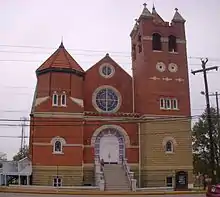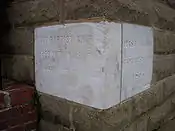First Baptist Church (Montgomery, Alabama)
The First Baptist Church (also known as the Brick-A-Day Church) on North Ripley Street in Montgomery, Alabama, is a historic landmark. Founded in downtown Montgomery in 1867 as one of the first black churches in the area, it provided an alternative to the second-class treatment and discrimination African-Americans faced at the other First Baptist Church in the city.
| First Baptist Church | |
|---|---|
 Front of the First Baptist Church | |

| |
| Location | North Ripley Street, Montgomery, Alabama |
| Country | United States |
| Denomination | Baptist |
| Website | http://www.firstbaptistchurchmontgomery.com |
| History | |
| Founded | 1866 |
| Architecture | |
| Architect(s) | W.T. Bailey |
| Style | Romanesque Revival |
| Completed | 1910–1915 (present building) |
| Clergy | |
| Pastor(s) | E. Baxter Morris |
In the first few decades after its establishment the First Baptist Church became one of the largest black churches in the South, growing from hundreds of parishioners to thousands. Almost a hundred years later, in the 1950s and 1960s, it was an important gathering place for activities related to the Civil Rights Movement, and became associated with the Montgomery bus boycott and the Freedom Rides of May 1961. The church was listed by the Alabama Historical Commission on the Alabama Register of Landmarks and Heritage on May 5, 2000.[1]
History

The congregation first organized in 1866; early parishioners had worshiped during slavery at the other First Baptist Church in Montgomery, on Perry Street. Before the American Civil War, blacks were allowed only on the balcony of that church: "they were never allowed on the main floor of the sanctuary unless they were sweeping or mopping."[2] In 1867, 700 African-American communicants had marched to an empty lot on the corner of Ripley Street and Columbus Street, declaring themselves the "First Baptist Church (Colored)" and founding what became "the first 'free Negro' institution in the city."[3] The wooden building itself, which faced north to Columbus Street, was called the Columbus Street Baptist Church.
The first pastor was Nathan Ashby, who also became the first president of the Colored Baptist Convention in Alabama, founded in his church on December 17, 1868.[4] Ashby retired in 1870, after being struck by paralysis. He was followed, briefly, by J.W. Stevens, and starting in 1871, James H. Foster was the pastor for twenty years. Foster is credited with increasing membership from a few hundred to several thousand; his successor, pastor Andrew Stokes, added even more.[5]
Fire destroyed the first frame church. Between 1910 and 1915, the church was rebuilt (now facing east, toward Ripley Street) under the leadership of pastor Stokes. Members of the congregation were asked to each bring a brick a day to build it—hence the church's nickname, the "Brick-A-Day Church."[6] The building was designed in the style of the Romanesque Revival by W.T. Bailey of the Tuskegee University.[7]
Civil Rights Movement

From 1952 to 1961, the church was led by civil rights activist Ralph Abernathy, a good friend of Martin Luther King Jr., who preached a few blocks away, at the Dexter Avenue Baptist Church, from 1954 to 1960. During the Montgomery bus boycott (1955–1956), it was the location of mass meetings;[8] Abernathy was a confidante of Edgar Nixon and quickly became involved with the boycott.[9] After the boycott was over, and the buses in Montgomery were desegregated, occasionally buses would get ambushed and shot at. One such shooting, on January 10, 1957,[7] was followed by bombings at Montgomery's Bell Street Baptist Church, the Mount Olive Baptist Church, the Hutchinson Street Baptist Church, and the First Baptist Church and its parsonage (Abernathy's residence).[10] Raymond C. Britt, Jr., was charged with the bombing of the First Baptist Church, and Henry Alexander and James D. York were charged with the bombing of Abernathy's house, but city prosecutor D. Eugene Loe ended up dropping the charges.[11]
In the spring of 1958, the basement of the church was the site of the formal initiation of John Lewis into the civil rights movement. Lewis, who had been active at American Baptist College and Fisk University in Nashville, Tennessee, was planning to enroll at Troy State University in an attempt to desegregate the school, and was invited to Montgomery: at First Baptist Church in the pastor's office in the basement, he met Abernathy and King.[12]
First Baptist Church Siege
On May 21, 1961, the church was a refuge for the passengers on the Freedom ride which met with violence at the Greyhound Bus Station in downtown Montgomery. The church was filled with some 1500 worshipers and activists, including Martin Luther King Jr., Fred Shuttlesworth, Diane Nash, and James Farmer.[13] The building was besieged by 3000 whites who threatened to burn it.[14] In the basement, Dr. King, in the company of Abernathy, Wyatt Tee Walker, James Farmer, and John Lewis, was on the phone with United States Attorney General Robert F. Kennedy, while bricks were thrown through the windows and tear gas came drifting in. According to Lewis, Kennedy jokingly asked King to say a prayer, since he was in a church anyway; the activists in the basement were not amused.[15] The events of 20–21 May 1961, including the "siege of First Baptist," played a crucial part in the desegregation of interstate travel.[16]
Robert and John F. Kennedy both pleaded with John Malcolm Patterson, governor of Alabama at the time, to cooperate and help protect the people inside First Baptist Church. Eventually, around 10PM, Patterson placed the city under "qualified-martial rule". A large group of city policemen along with more than a hundred members of the Alabama National Guard had swarmed to First Baptist Church and created a shield around it. Former marshals on the scene were placed under the National Guard command. Shortly after the mob was finally dispersed. Yet the citizens in the church continued to be held in a siege by the National Guardsmen.[17]
At around 4AM, assistant attorney general William Orrick, worked out a deal with the Adjutant General of the National Guards, Henry Graham, to release everyone in the church. National Guard trucks and Jeeps were sent to retrieve the Freedom Riders and parishioners out of the church.[18]
Historical marker
 Historical marker, front view
Historical marker, front view Historical marker, back view
Historical marker, back view
References
Notes
- "Properties on the Alabama Register of Landmarks & Heritage". Alabama Historical Commission. www.preserveala.org. Archived from the original on September 4, 2012. Retrieved October 25, 2012.
- Williams and Greenhaw 101.
- Link 32.
- Boothe 37.
- Boothe 57-58.
- Townsend 38.
- Historical marker at the First Baptist Church.
- Carrier 243-44.
- Williams and Greenhaw 58.
- Williams and Greenhaw 260-61.
- Williams and Greenhaw 264.
- Lewis 68-69.
- Farmer 204.
- Schlesinger 296-300.
- Lewis 160.
- Cobb 226.
- Arsenault 237.
- Arsenault 242.
Bibliography
- Arsenault, Raymond (2006). Freedom Riders: 1961 and the Struggle for Racial Justice. Oxford UP. ISBN 9780199755813.
- Boothe, Charles Octavius (1895). The cyclopedia of the colored Baptists of Alabama: their leaders and their work. Alabama Publishing Company. p. 57. ISBN 978-0-415-21664-7.
- Carrier, Jim (2003). A traveler's guide to the civil rights movement. Houghton Mifflin Harcourt. p. 243. ISBN 978-0-15-602697-0.
- Cobb, Charles E. (2008). On the road to freedom: a guided tour of the civil rights trail. Algonquin Books. p. 226. ISBN 978-1-56512-439-4.
- Davis, Townsend (1999). Weary Feet, Rested Souls: A Guided History of the Civil Rights Movement. Norton. ISBN 978-0-393-31819-7.
- Farmer, James (1985). Lay Bare the Heart: An Autobiography of the Civil Rights Movement. TCU Press. p. 204. ISBN 9780875651880. Retrieved 30 April 2013.
- Lewis, John; Michael D'Orso (1998). Walking with the Wind: A Memoir of the Movement. New York: Harcourt Brace & Company. ISBN 978-0-618-21928-5.
- Ling, Peter John (2002). Martin Luther King, Jr. Routledge. p. 32. ISBN 978-0-415-21664-7.
- Schlesinger, Arthur M. (2002). Robert Kennedy and His Times. Houghton Mifflin Harcourt. ISBN 978-0-618-21928-5.
- Williams, Donnie; Wayne Greenhaw (2006). The thunder of angels: the Montgomery bus boycott and the people who broke the back of Jim Crow. Chicago Review Press. ISBN 978-1-55652-590-2.